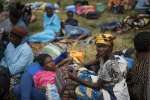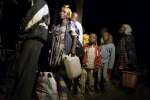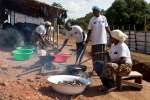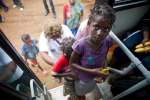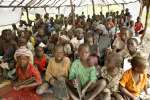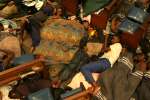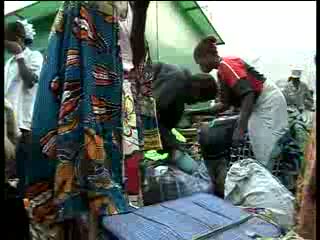Weaving a refugee legacy into Botswana's baskets
News Stories, 25 April 2005
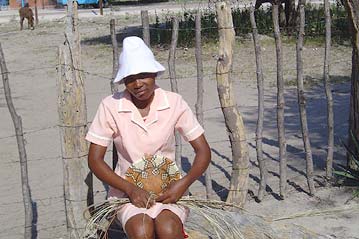
ETSHA, Botswana, April 25 (UNHCR) – Tourists visiting Botswana invariably buy some of the colourful baskets on offer in crafts shops to take home as souvenirs. Little do they know that these baskets are the material proof of one of the most successful refugee integration stories in southern Africa. The baskets are made by women whose parents and grandparents came to the country as refugees from Angola. They brought with them traditional basket-weaving skills and combined them with the dyes and colourful patterns that are part of Botswana's culture.
The history of Etsha settlement in north-western Botswana dates back to 1967 when 3,300 refugees from the Hambukushu tribe in southern Angola crossed into Botswana, fleeing Portuguese attacks during Angola's war of independence. In those days, Portuguese forces used to attack villages, burn the houses and take the livestock away, leaving the Hambukushu without any means of subsistence and finally forcing them to leave their territories.
The first arrivals in Botswana were recorded in December 1967. Reverend Wynne, a priest who worked with the refugees for many years, describes how they came in a terrible state: "They were naked except for a rough cloth covering their middle. The women had simple traditional ornaments and carried a plaited screen mat, a bundle with a few things and a water pot on their heads."
The refugees had nothing to eat but wild fruits in the bush. Emaciated and weakened by war and famine, many people died of sleeping sickness. In order to survive, the refugees looked for work among the Bayeye people who were traditionally farming the Etsha region of northern Botswana.
When the Hambukushu first arrived in Botswana, they were met by a wave of overwhelming hospitality and support. In order to give the newly-arrived refugees a status in Botswana, the Paramount Chief of the Batawana, Letsholatebe, adopted them as members of his tribe and allocated them land. The refugees were settled in 13 villages.
The UN launched an emergency feeding programme, provided agricultural tools and seeds while the national Red Cross helped with medicine. The Botswana government sent an agricultural expert to train the Hambukushu on how to farm on a soil and in a climate foreign to them. The District Council financed the building of a school. Literacy training for children and adults was organised.
So a joint effort took place to helped turn a desperate group of uprooted people into the thriving community of Etsha today. The Hambukushu are resourceful people, they grow maize, pumpkins and watermelons and occupy themselves with brick-making, bee-keeping, and reed trade. But above all, they are known for their basket-making skills.
The elaborate baskets are made of palm fibre that is dyed with roots or bark to achieve different shades of brown, orange and cream. They sell their baskets to the Botswana Council of Churches (BCC), which sells them to craft traders in Botswana and abroad. These baskets are of high quality and beautiful design and are among the finest pieces of craft produced in Africa.
Katutu has been working in the basket project for five years. On behalf of the BCC, she receives the order, buys the basket from the women in the village and prepares the shipments to the capital. She also supervises the basket shop in Etsha.
The integration of these former refugees in Botswana is so thorough, that the young women in the shop are not at all interested in answering questions about the past. They prefer to talk about the baskets that put them on the world map. They are particularly proud of the fact that one of the Etsha women represented them at an international Black Arts Festival held during the Atlanta Olympic Games in 1994.
Each basket is a unique piece of art and therefore carries a tag with the name of the woman who made it. Katutu explains that the patterns have colourful names such as "running ostrich", "zebra's forehead", "shield" and "clay pot".
As the women of Etsha proudly show their products, the plight of the former Angolan refugees seems like only a distant myth of the past.

Today, the young generation of Hambukushu in Etsha is blissfully unaware of the early suffering of their grandparents and parents. They have nice brick houses, a few cars, a church and a school. In addition to the 300 to 400 women who weave baskets, some of the men work in the mines while others are farmers. They belong to the area and never felt like foreigners, although they know that their families migrated from Angola.
Currently, the last 377 inhabitants of Etsha are receiving their Botswana identity documents. But this is only an act of paperwork that remains to be completed. The villagers have regarded themselves as Botswana citizens for a long time already, as have the authorities and the local community.
By Melita H. Sunjic in Etsha, Botswana







